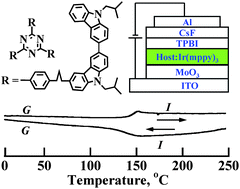Comprising hole- and electron-transporting moieties with flexible linkages, representative non-conjugated bipolar hybrids have been synthesized and characterized for a demonstration of their potential use as host materials for the fabrication of phosphorescent organic light-emitting diodes. The advantages of this material class include solution processing into amorphous films with elevated glass transition temperatures, stability against phase separation and crystallization, and provision of LUMO/HOMO levels and triplet energies contributed by the two independent moieties without constraint by the electrochemical energy gap. While exciplex formation between the hole- and electron-transporting moieties is inevitable, its adverse effects on spectral purity and device efficiency can be avoided by trapping charges on triplet emitters, as demonstrated for Ir(mppy)3 in TRZ-3Cz(MP)2, and TRZ-1Cz(MP)2. With these two bipolar hybrids and hole-transporting Cz(MP)2 as the host, the maximum current efficiency of the bilayer PhOLED is achieved with TRZ-3Cz(MP)2, but the driving voltage decreases monotonically with an increasing TRZ content.

You have access to this article
 Please wait while we load your content...
Something went wrong. Try again?
Please wait while we load your content...
Something went wrong. Try again?


 Please wait while we load your content...
Please wait while we load your content...